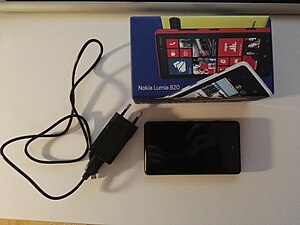The Nokia Lumia 820 is a smartphone[4] designed, developed and marketed by Nokia. It is the successor to the Lumia 800 and is one of the first Nokia phones to implement Windows Phone 8 alongside the Nokia Lumia 920. Although sharing a similar appearance with the Lumia 800, the Lumia 820 is a major overhaul over its predecessor, sporting a 4.3 inches (110 mm) diagonal OLED display with scratch resistant glass, though lacking Gorilla Glass protection, 1.5 GHz dual-core processor, and an 8.7-megapixel camera.[5][6] The phone will come with LTE connectivity and a wireless-charging option.[7] The 820 is the first Nokia Windows Phone OS based smartphone to embed a microSD card slot.[8]
 | |
| Brand | Nokia |
|---|---|
| Manufacturer | Nokia |
| Type | Smartphone |
| Series | Nokia Lumia |
| First released | November 7, 2012 |
| Discontinued | 2014 |
| Predecessor | Nokia Lumia 800 |
| Successor | Nokia Lumia 830 |
| Related | Nokia Lumia 810, Nokia Lumia 822, Nokia Lumia 920 |
| Compatible networks | GSM/GPRS/EDGE 850/900/1800/1900 HSPA 850/900/1900/2100 LTE 800/900/1800/2100/2600 Wi-Fi |
| Form factor | Slate |
| Dimensions | 123.8 mm (4.87 in) H 68.5 mm (2.70 in) W 9.9 mm (0.39 in) D |
| Weight | 160 g (5.6 oz) |
| Operating system | Windows Phone 8, upgradeable to 8.1 |
| System-on-chip | Qualcomm Snapdragon S4 MSM8960 |
| CPU | 1.5 GHz dual-core Qualcomm Krait |
| GPU | Qualcomm Adreno 225 |
| Memory | 8 GB internal flash 1 GB RAM |
| Removable storage | MicroSD (up to 64 GB) |
| Battery | Removable & rechargeable BP-5T 1650 mAh Lithium polymer battery,[1] Qi wireless charging (with optional charging shell) |
| Rear camera | 8-megapixel, 3264×2448 pixels, Power Dual-LED flash, autofocus Carl Zeiss optics, 1080p video capture |
| Front camera | VGA, 640×480 pixels |
| Display | 4.3" AMOLED ClearBlack capacitive touchscreen with Super Sensitive Touch 800×480 px 16.7m-color |
| Connectivity | Bluetooth 3.1 (Bluetooth 4.0 certified but not yet supported by WP8,[2][3]) 802.11a/b/g/n, NFC |
| Data inputs | Multi-touch capacitive touchscreen, proximity sensor, ambient light sensor, Gyroscope, Magnetometer, 3-axis accelerometer |
| Website | Microsoft Lumia |
On October 9, 2012, the largely similar Nokia Lumia 810 was presented. The main differences are more talk time (10.2 hours) due to the larger 1800 mAh battery, an improved 1.3-megapixel front-facing camera, lighter weight, wider and longer dimensions. The Lumia 810 is exclusively made available to T-Mobile customers in the United States, and as such does not support LTE but only HSPA+, as LTE was not supported in T-Mobile's US network at the time of release.[9]
On October 29, 2012, another variant of the Lumia 820, the Nokia Lumia 822 was announced, having a better front camera, larger battery and double the storage.[10] It is exclusively available for Verizon customers.[11][12][13]
Swappable rear Shells
The phone features a range of back 'Shells' which will allow users to customise the look of their phone as well as adding functionality such as Wireless charging, if a shell with that capability is added. This feature gives the additional benefit of allowing a scuffed or broken shell to be replaced with a new one to freshen up the device, something which is not possible on some competing smartphones such as the iPhone or unibody Lumia designs such as the 900 and 920. It additionally allows user access to the battery so that a battery which no longer holds a charge can be replaced with a new one, or, if on a long trip away from a charger, the user to swap a spare fully charged battery for an empty one, increasing the time the phone can be used for.
Reception
Jeff Parsons from Techradar wrote: "The Nokia Lumia 820 sits nicely at the crossroads between value and power. While it doesn't have the processor, camera or larger screen of its big brother the Lumia 920, it does have microSD storage, removable covers and a more attractive price tag."[14]
Mike Jennings from PC Pro wrote: "The low-resolution screen, weaker camera and continued lack of apps mean it can’t compete with the best Android handsets, but the usability of Windows 8 and attractive physical design mean this well-balanced Nokia is still an attractive proposition."[15]
Stuart Miles from Pocket-Lint.com wrote: "This is the phone Nokia should be putting all its efforts into promoting. Agreed it isn’t the flagship and agreed the camera isn't nearly anywhere as good as on the 920, but this is a phone you'll be happy to use, a phone you'll enjoy using, and besides a lack of third-party apps at the moment, a phone that for many people will be a fantastic phone they will enjoy for the next two years."[16]
Model variants
| Model | RM-824 | RM-825 | RM-826 |
|---|---|---|---|
| Countries | Mexico, United States | International | China, India |
| Carriers/Providers | Telcel, AT&T | International | |
| 2G | Quad band GSM/EDGE (850/900/1800/1900 MHz) | ||
| 3G | Quad-Band HSPA+ 1, 2, 5/6, 8 (850/900/1900/2100 MHz) | Penta-band HSPA+ 1, 2, 4, 5/6, 8 (850/900/AWS/1900/2100 MHz) | |
| 4G | Dual-Band LTE 4 and 17 (1700/700 MHz) | Penta-band LTE 1, 3, 7, 8, 20 (2100/1800/2600/900/800 MHz) | yes |
| Max network speed | LTE: 100 Mbit/s | ||
See also
References
External links
Wikiwand in your browser!
Seamless Wikipedia browsing. On steroids.
Every time you click a link to Wikipedia, Wiktionary or Wikiquote in your browser's search results, it will show the modern Wikiwand interface.
Wikiwand extension is a five stars, simple, with minimum permission required to keep your browsing private, safe and transparent.
